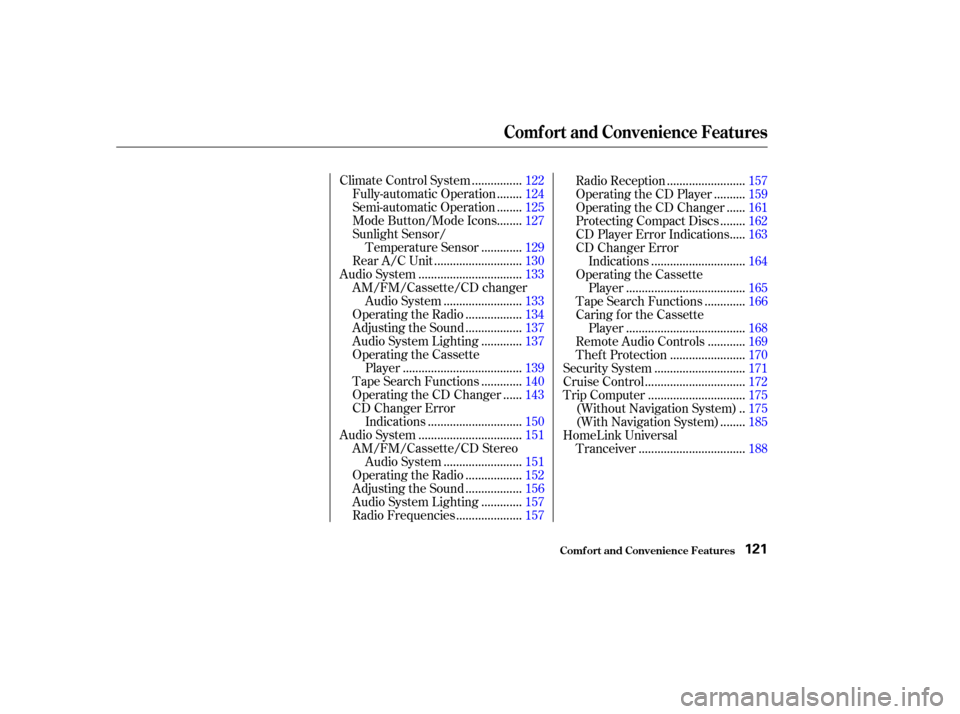sensor Acura MDX 2002 Owner's Manual
[x] Cancel search | Manufacturer: ACURA, Model Year: 2002, Model line: MDX, Model: Acura MDX 2002Pages: 372, PDF Size: 5.48 MB
Page 54 of 372

Your Supplemental Restraint System
(SRS) includes:Two f ront airbags. The driver’s
airbag is stored in the center of
the steering wheel; the f ront
passenger’sairbagisstoredinthe
dashboard. Both are marked ‘‘SRS
AIRBAG.’’
If you ever have a moderate to
severe f rontal collision, the sensors
will detect the vehicle’s rapid
deceleration. If the rate of
deceleration is high enough, the
control unit will instantly inf late the
f ront airbags.
Automatic seat belt tensioners
that tighten the front seat belts in
the event of a moderate to severe
f rontal collision (see page ).
Sensors that can detect a
moderate to severe frontal
collision.
A sophisticated electronic system
that continually monitors and
records inf ormation about the
sensors, the control unit, the
airbag activators, and driver and
passenger seat belt use when the ignition is ON (II).
An indicator light on the
instrument panel that alerts you to
a possible problem with the
system (see page ).
Emergency backup power in case
your vehicle’s electrical system is
disconnected in a crash.
48 53
SRS Components How Your Front A irbags Work
Driver and Passenger Saf ety
Additional Inf ormation About Your Airbags
50
01/09/07 12:03:37 31S3V610_055
Page 55 of 372

After a crash, you may see what
looks like smoke. This is actually
powder f rom the airbag’s surf ace.
Although the powder is not harmf ul,
people with respiratory problems
mayexperiencesometemporary
discomf ort. If this occurs, get out of
the vehicle as soon as it is saf e to do
so.
For additional information on how
your airbags work, see the booklet
titledthat came with your
owner’s manual.
The total time for inflation and
def lation is approximately one-tenth
of a second, so f ast that most
occupants are not aware that the
airbags deployed until they see them
lying in their laps. For additional information on how
your airbags work, ask your dealer
f or a copy of the booklet titled
During a f rontal crash, your seat
belts help restrain your lower body
and torso. Your airbag provides a
cushion to help restrain and protect
your head and chest.
Since both airbags use the same
sensors, both airbags normally
inf late at the same time. However, it
is possible f or only one airbag to
inf late.
This can occur when the severity of
a collision is at the margin, or
threshold, that determines whether
or not the airbags will deploy. In
such cases, the seat belt will provide
suf f icient protection, and the
supplemental protection of f ered by
the airbag would be minimal.
Af ter inf lating, the f ront airbags
immediately def late, so they won’t
interf ere with the driver’s visibility,
or the ability to steer or operate
other controls.
SRS: What You Need to Know
About Airbags
SRS:
What You Need to Know About Airbags
.
Driver and Passenger Saf ety
Additional Inf ormation About Your Airbags
U.S. Owners
Canadian Owners
51
01/09/07 12:03:47 31S3V610_056
Page 56 of 372

Your vehicle is equipped with side
airbags f or the driver and a f ront
seat passenger. The airbags are
stored in the outer edges of the f ront
seat-backs, and both are marked
‘‘SIDE AIRBAG.’’If you ever have a moderate to
severe side impact, the sensors will
detect rapid deceleration and signal
the control unit to instantly inf late
either the driver’s or the passenger’s
side airbag.
Only one airbag will deploy during a
side impact. If the impact is on the
passenger’s side, the passenger’s
side airbag will deploy even if there
is no passenger.
To get the best protection f rom the
side airbags, front seat occupants
should wear their seat belts and sit
upright and well back in their seats.
Additional Inf ormation About Your Airbags
Driver and Passenger Saf ety
How Your Side A irbags Work
52
01/09/07 12:03:55 31S3V610_057
Page 103 of 372

Both f ront seats are equipped with
seat heaters. The ignition switch
must be ON (II) to use them. Push
the front of the switch, HI, to rapidly
heat up the seat. After the seat
reaches a comf ortable temperature,
select LO by pushing the back of the
switch. This will keep the seat warm.Follow these precautions whenever
you use the seat heaters:
Use the HI setting only to heat the
seats quickly. Select the LO
setting when the seats f eel warm.
The HI setting draws large
amounts of current f rom the
battery.
Do not use the seat heaters, even
on the LO setting, if the engine is
lef t idling f or an extended period.
They can weaken the battery,
causing hard starting.
The HI or LO indicator lights and
remains lit until you turn it of f by
pushing the opposite side of the
switch lightly. The indicator will turn
off.
In HI, the heater turns of f when the
seat gets warm, and turns back on
after the seat’s temperature drops. It
continues to cycle as long as you
leave it set on HI. The HI indicator
remains lit as a reminder that you
have the heater on.
In LO, the heater runs continuously.
It does not cycle with temperature
changes.
Because of the sensors f or the side
airbag system, there is no heater in
the passenger’s seat-back.
Inst rument s and Cont rols
Seat Heaters
Seat Heaters
99
S SE
EA
A T
T H
HE
EA
A T
TE
ER
RS S
01/09/07 12:11:36 31S3V610_104
Page 125 of 372

...............
Climate Control System .122
.......
Fully-automatic Operation .124
.......
Semi-automatic Operation .125
.......
Mode Button/Mode Icons .127
Sunlight Sensor/
............
Temperature Sensor .129
...........................
Rear A/C Unit .130
................................
Audio System .133
AM/FM/Cassette/CD changer ........................
Audio System .133
.................
Operating the Radio .134
.................
Adjusting the Sound .137
............
Audio System Lighting .137
Operating the Cassette
.....................................
Player .139
............
Tape Search Functions .140
.....
Operating the CD Changer .143
CD Changer Error
.............................
Indications .150
................................
Audio System .151
AM/FM/Cassette/CD Stereo ........................
Audio System .151
.................
Operating the Radio .152
.................
Adjusting the Sound .156
............
Audio System Lighting .157
....................
Radio Frequencies .157 ........................
Radio Reception .157
.........
Operating the CD Player .159
.....
Operating the CD Changer .161
.......
Protecting Compact Discs .162
....
CD Player Error Indications .163
CD Changer Error
.............................
Indications .164
Operating the Cassette .....................................
Player .165
............
Tape Search Functions .166
Caring f or the Cassette
.....................................
Player .168
...........
Remote Audio Controls .169
.......................
Thef t Protection .170
............................
Security System .171
...............................
Cruise Control .172
..............................
Trip Computer .175
.
(Without Navigation System) .175
.......
(With Navigation System) .185
HomeLink Universal .................................
Tranceiver .188
Comf ort and Convenience Features
Comf ort and Convenience Feat ures121
01/09/07 12:14:47 31S3V610_126
Page 133 of 372

Theclimatecontrolsystemhastwo
sensors. A sunlight sensor is located
in the top of the dashboard and a
temperature sensor is next to the
steering column. Do not cover the
sensors or spill any liquid on them. Sunlight Sensor/T emperature
Sensor
Climat e Cont rol Syst em
Comf ort and Convenience Feat ures129
T TE
EM
M P
PE
ER
RA A T
TU
UR REE S
SEEN
NS SOOR R
S
SU UN NLLIIGGH HT
T S
SEEN
NS SOOR R
01/09/07 12:15:54 31S3V610_134
Page 315 of 372

Two f actors normally contribute to
causing corrosion in your vehicle:Moisture trapped in body cavities.
Dirtandroadsaltthatcollectsin
hollows on the underside of the
vehicle stays damp, promoting
corrosion in that area.
Removal of paint and protective
coatings f rom the exterior and
underside of the vehicle. Repair chips and scratches in the
paint as soon as you discover them.
Inspect and clean out the drain
holes in the bottom of the doors
and body.
Check the f loor coverings f or
dampness. Carpeting and f loor
mats may remain damp f or a long
time, especially in winter. This
dampness can eventually cause
the f loor panels to corrode.Use a high-pressure spray to clean
the underside of your vehicle. This
is especially important in areas
that use road salt in winter. It is
also a good idea in humid climates
and areas subject to salt air. Be
caref ul of the ABS wheel sensors
and wiring at each wheel.
Have the corrosion-preventive
coatings on the underside of your
vehicle inspected and repaired
periodically.
Many corrosion-preventive measures
are built into your Acura. You can
help keep your vehicle f rom
corroding by perf orming some
simple periodic maintenance:
1.
2.
Corrosion Prot ect ion
Appearance Care311
01/09/07 12:44:53 31S3V610_316
Page 351 of 372

If you are planning to take your
Acura outside the U.S., contact the
tourist bureaus in the areas you will
betravelingintofindoutaboutthe
availability of unleaded gasoline with
theproperoctanerating.
If unleaded gasoline is not available,
be aware that using leaded gasoline
in your Acura will af f ect perf or-
mance and fuel mileage, and damage
its emissions controls. It will no
longer comply with U.S. and
Canadian emissions regulations, and
will be illegal to operate in North
America. To bring your vehicle back
into compliance will require the re-
placement of several components,
such as the oxygen sensors and the
three way catalytic converter. These
replacements are not covered under
warranty.
T echnical Inf ormation
Driving in Foreign Countries
347
01/09/07 12:50:34 31S3V610_352
Page 353 of 372

The exhaust emissions controls
include f our systems: PGM-FI,
Ignition Timing Control, Exhaust
Gas Recirculation and Three Way
Catalytic Converter. These four
systems work together to control the
engine’s combustion and minimize
the amount of HC, CO, and NOx that
comes out the tailpipe. The exhaust
emissions control systems are
separate f rom the crankcase and
evaporative emissions control
systems.The emissions control systems are
covered by warranties separate from
the rest of your vehicle. Read your
warranty manual f or more informa-
tion.
The PGM-FI System uses sequential
multiport f uel injection.
It has three subsystems: Air Intake,
Engine Control, and Fuel Control.
The Powertrain Control Module
(PCM) uses various sensors to
determine how much air is going
into the engine. It then controls how
much f uel to inject under all operat-
ing conditions. This system constantly adjusts the
ignition timing, reducing the amount
of HC, CO, and NOx produced.
The Exhaust Gas Recirculation
(EGR) system takes some of the
exhaust gas and routes it back into
the intake manif old. Adding exhaust
gas to the air/f uel mixture reduces
the amount of NOx produced when
the f uel is burned.
The three way catalytic converter is
in the exhaust system. Through
chemical reactions, it converts HC,
CO, and NOx in the engine’s exhaust
to carbon dioxide (CO ), dinitrogen
(N ), and water vapor.
The emissions control systems are
designed and certif ied to work to-
gether in reducing emissions to
levels that comply with the Clean Air
Act. To make sure the emissions
remain low, you should use only new
genuine Acura replacement parts or
their equivalent f or repairs. Using
lowerqualitypartsmayincreasethe
emissions f rom your vehicle.
2
2
Exhaust Emissions Controls Replacement Parts
PGM-FI Syst emIgnit ion T iming Cont rol Syst em
Exhaust Gas Recirculat ion (EGR)Syst em
Three Way Catalytic Converter
T echnical Inf ormation
Emissions Cont rols
349
01/09/07 12:50:56 31S3V610_354